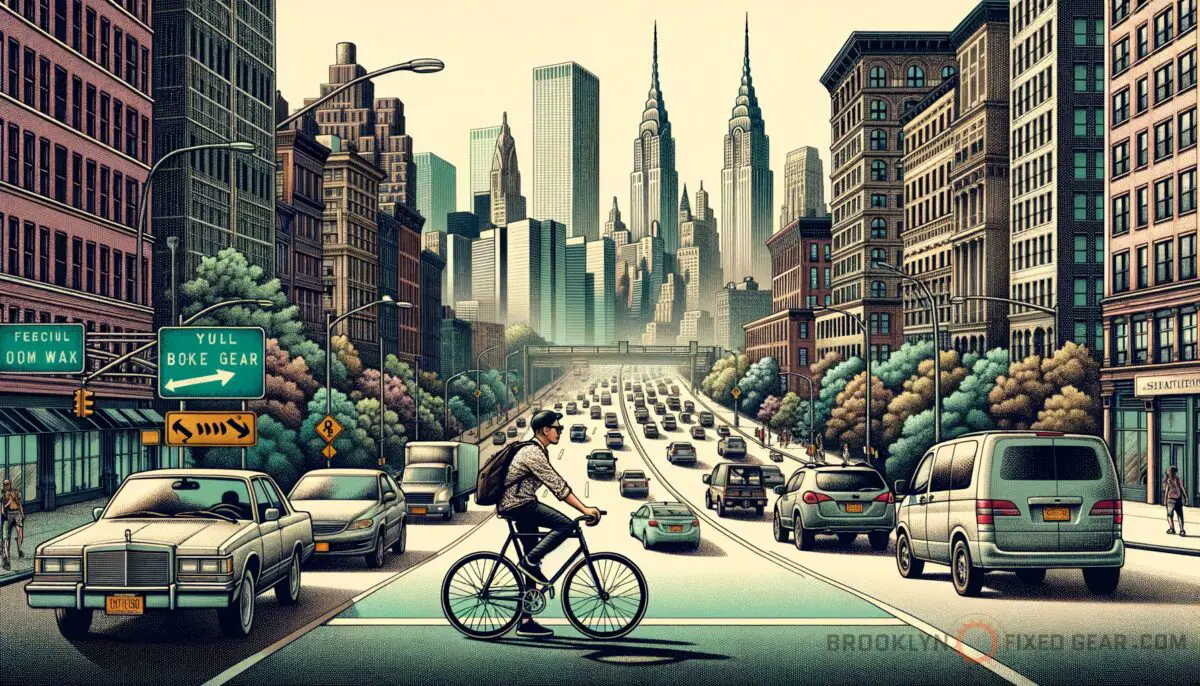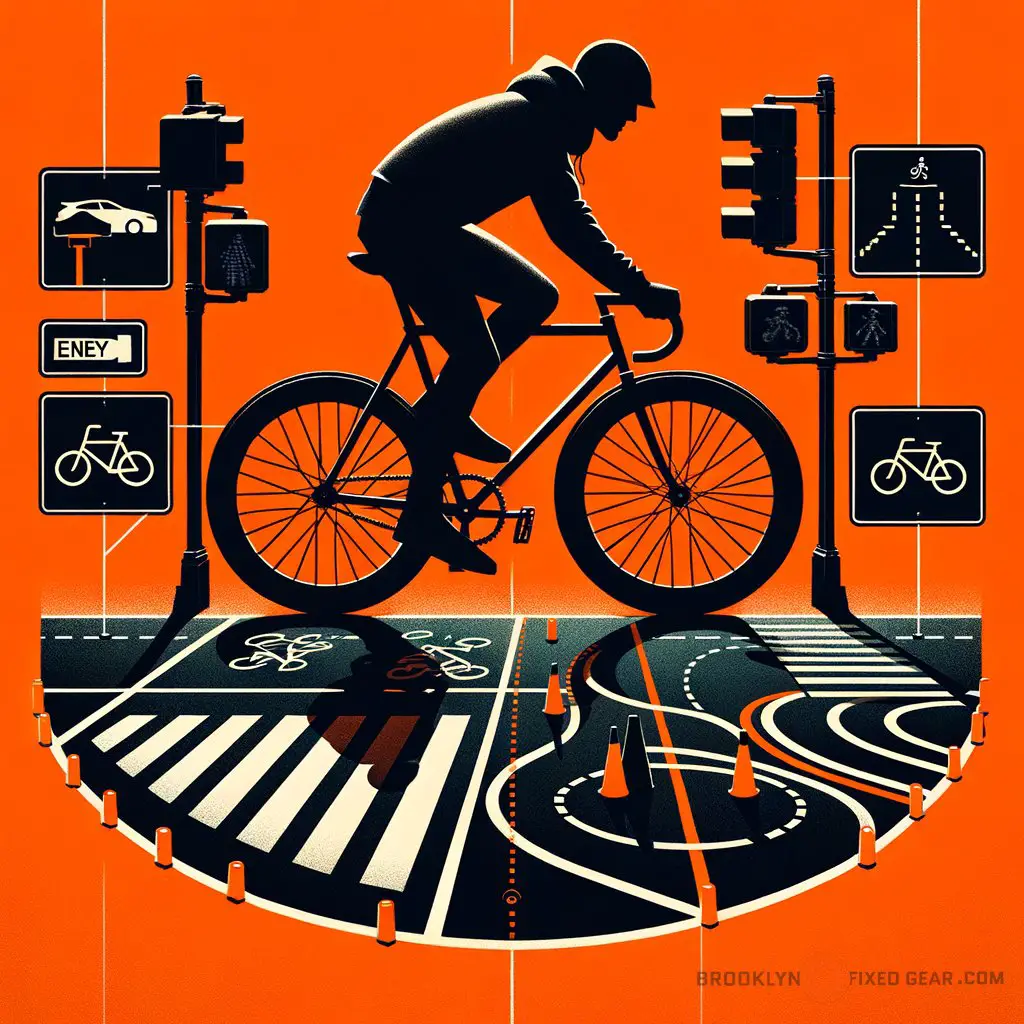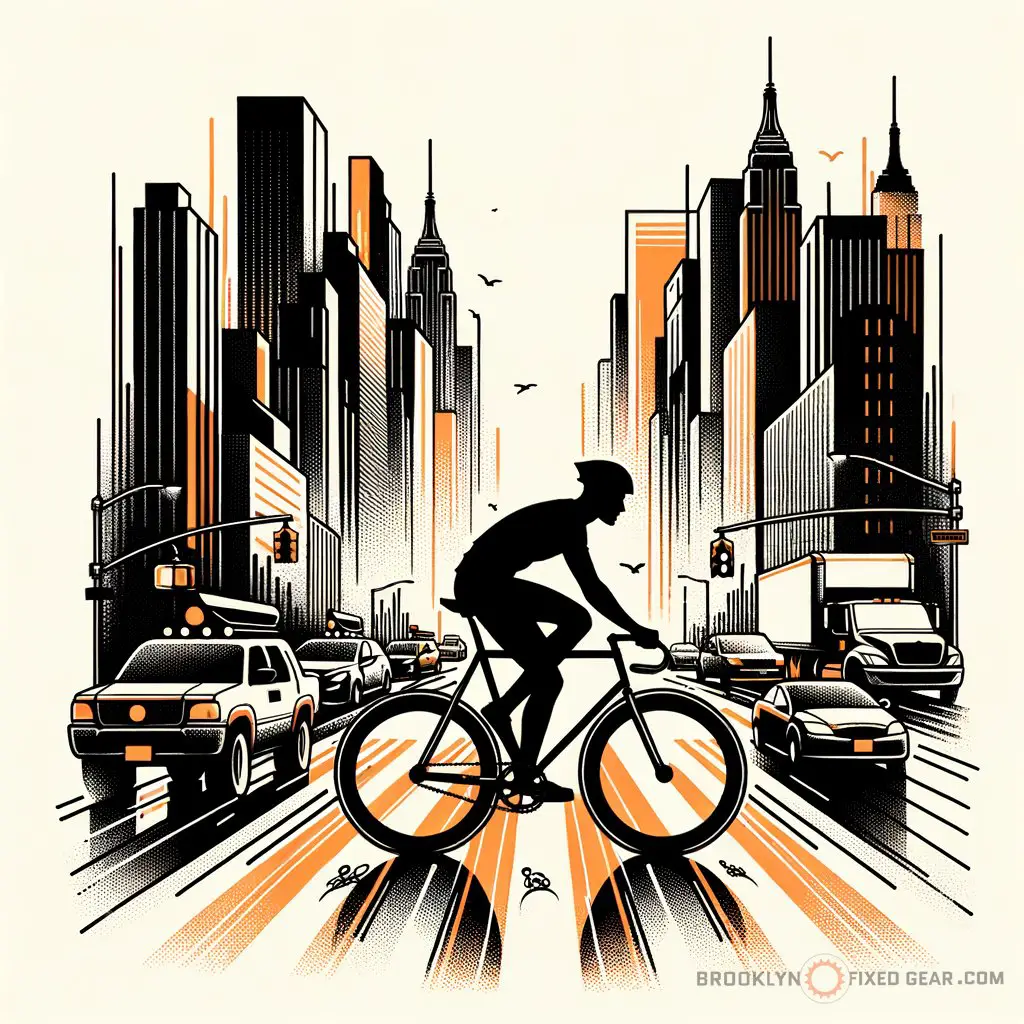Cruising down the bustling streets of NYC on my slick fixie, I weave through traffic, feeling the pulse of the city beneath me. Have you ever pondered how urban infrastructure shapes our fixed-gear experience? Together, we’ll explore vital nuances that impact our rides and, for all you beginners out there, discover why a fixie might be the perfect ride for you.
Key takeaways
- Dedicated bike lanes significantly enhance the fixie experience.
- Smooth pavement is essential for uninterrupted rides.
- Urban planning must include fixie-friendly designs to foster a safe cycling culture.
How does the city’s design influence your fixie ride?
Navigating through the concrete jungle on a fixed-gear bike is an experience like no other. It’s the harmonious blend of city architecture and the raw simplicity of a fixie that can either make or break your ride. But let’s zoom in on the specifics.

What elements of urban infrastructure can transform your pedaling into poetry? Here’s a numbered lowdown on factors that greatly affect fixed-gear enthusiasts as they chart their paths on city streets.
1. Bike lanes and paths
Boxed in by four wheels? Not anymore. Dedicated bike lanes promote safer and more enjoyable rides for fixed-gear cyclists. They minimize the tangle with motor vehicles and open up space where riders can confidently unleash the true potential of their fixies. The increased presence of bike lanes in major cities marks a nod of recognition towards the cycling community, creating environments where fixies aren’t just tolerated, but celebrated.
An absence of bike lanes, on the other hand, keeps fixie riders on their toes, as they are usually nudged into sharing space with larger, faster vehicles. This not only intimidates newer riders but also cramps the style of seasoned ones who prefer the free-flowing vibe that only adequate cycling infrastructure can offer.
2. Traffic calming measures
When it comes to riding fixed-gear, momentum is everything. Speed bumps and traffic circles can interrupt that sweet rhythm we all crave. Traffic calming measures slow us down, and for some, that’s a buzzkill.

But here’s the twist: these features can also be a fixed-gear rider’s ally, as they encourage a slower traffic flow, making the streets a tad safer for those of us who are brakeless and bold.
However crucial they may be for safety, poorly designed traffic calming measures can become obstacles in our urban playground. Ideally, cities should design these with our lightweight, agile fixies in mind, so we can keep our pace smooth and our rides sharp.
3. Road quality and maintenance
Potholes and cracks are the nemesis of every cyclist, but for the fixie rider, they are especially treacherous. A smooth pavement is the canvas we require for the art of fixed-gear cycling. Going full throttle on a sleek track bike demands a level of predictability that only well-maintained roads can offer.
Meanwhile, bad road conditions don’t just mess with the comfort of our ride; they can compromise the integrity of our bikes. Every jolt and jar rattles our steed’s components, some as delicate and precise as a watch’s gears. Adequate road maintenance keeps our wheels spinning and our minds at ease, letting us focus on the experience rather than dodging urban craters.
4. Urban planning and accessibility
Imagine a city sprawl designed not around cars but cyclists, where destinations are connected by greenways and cycling highways, catering to the fixie fanatics. Such planning doesn’t just uplift our cycling experience; it symbolizes a cultural shift, embracing bikes as a primary mode of transport.
Conversely, when cycling is an afterthought in city planning, it shows. Inaccessible or disconnected routes can discourage riding, force us onto busier roads, or require us to navigate a labyrinth of backstreets. We yearn for more than just token bike racks; we need a cohesive network that acknowledges our presence and respects our passion.

5. Traffic laws and enforcement
In a perfect world, cars and bikes coexist peacefully, with mutual respect governing the roads. Enforced traffic laws play a crucial role in this delicate balance, ensuring that motor vehicles yield to cyclists when appropriate, and riders adhere to the rules of the road, keeping both parties safe.
Yet, inconsistent enforcement or a lack of awareness about fixed-gear cycling can lead to tensions and dangerous encounters. We aren’t just commuters; we’re part of the traffic flow, and recognition under the law affirms our right to the road. It’s about protection, not just for our bodies but for our right to ride unimpeded and in harmony with the heartbeat of the city.
State Bicycle Co. Black Label 6061

State Bicycle Co. Black Label 6061
More fixed-gear cycling tips
When you’re dialed into the fixed-gear lifestyle, there’s no end to the tweaks and changes you can make to optimize your ride. It’s all about pushing the experience from good to absolutely majestic. Here are some extra pro tips to enhance your fixie adventures through the urban landscape.
- Invest in quality components that can endure the rough and tumble of city riding.
- Personalize your setup. Find the best fixie bike handlebars that fit your riding style and posture.
- Regular maintenance is key. A well-oiled chain and tightened bolts can make a world of difference.
- Enhance visibility with lights and reflective gear, especially for those nocturnal jaunts.
- Always have a bike multi-tool on hand for on-the-go adjustments and fixes.
- Consider learning a few advanced riding techniques to maneuver more effectively in urban environments.
Dos and don’ts for urban cycling
Let’s pedal through some critical dos and don’ts that can safeguard your street cred and keep your fixie flying true through the avenues and alleyways.
| Do | Don’t |
|---|---|
| Wear a helmet for safety. | Ignore traffic signals and signs. |
| Use hand signals to communicate with motorists. | Ride against traffic. |
| Check your tire pressure before every ride. | Forget to lock up your bike securely. |
| Be aware of your surroundings at all times. | Wear earphones while riding. |
| Follow a regular maintenance routine for your fixie. | Neglect the impact of weather on your ride. |
“Imagine a city sprawl designed not around cars but cyclists, where destinations are connected by greenways and cycling highways, catering to the fixie fanatics.”
Remember: Awareness, preparation, and respect for the road can make every ride smoother and safer.
Advantages and disadvantages of fixed-gear cycling
Opting for a fixie is like choosing vinyl records over streaming services — it’s a choice that speaks to a certain purity of experience. Let’s break down the yin and yang of embracing the fixed-gear way of life in an urban setting.
Advantages
- Simplicity in mechanics means less maintenance and a cleaner aesthetic.
- Offers a pure cycling experience with direct control and connection to the bike.
- Improved pedaling efficiency and leg strength from continuous motion.
- The minimalistic design is usually lightweight, ideal for city maneuvering and carry-ups.
- Encourages better skill development as riders learn to use momentum and body movements.
Disadvantages
- Not ideal for steep hills or long-distance rides due to the single gear ratio.
- The brakeless system may pose challenges for riders in heavy traffic or emergency situations.
- Requires a higher level of skill and confidence, which can be intimidating for beginners.
- Fixed-gear bikes can be harsh on the knees without proper riding techniques.
- Limited versatility compared to multi-gear bikes in varying urban terrains.
Opinion
I’ve got to say, urban infrastructure plays a critical role in how much joy we extract from our fixed-gear excursions. Personally, when the city vibes with my fixie, it’s like a dance, both smooth and exhilarating. While I may not be an expert urban planner, I believe that cities with a keen eye on cycling infrastructure not only improve the quality of life for riders but also foster a more sustainable and connected community.
It’s more than just carving out space for bikes; it’s about crafting a vibe that uplifts the spirit of every rider. If you’re still on the fence, look into how to choose a perfect fixed-gear bike and you might just find yourself inspired to join the fixie movement.
If you are a visual learner, check out this video titled ‘Why Cities Need Cycling Infrastructure? Does Anti-cycling Mentality Exist?’
Frequently asked questions (FAQ)
What makes fixed-gear bikes special in urban settings?
Fixed-gear bikes stand out in urban environments due to their simplicity and efficiency. Their minimalist design cuts down on maintenance, and their direct drivetrain offers unmatched control, making navigation through tight city spaces almost intuitive.
How can city infrastructure be modified to accommodate fixed-gear cyclists?
Cities can implement dedicated bike lanes, smoother pavements, and traffic-calming measures that consider cyclists. Plus, having bike-friendly public transit options and secure parking can significantly enhance the urban cycling experience.
Are fixed-gear bikes suitable for beginners in a city environment?
While fixed-gear bikes are more challenging to master, they can be suitable for beginners who are willing to learn and practice. It’s essential to start in less busy areas and gradually build up to more congested streets while putting safety first.
Final thoughts
As the sun dips below the skyline, casting long shadows over the cityscape, we come to a halt at the intersection of urban design and fixed-gear culture. What’s evident is that the bones of a city — its lanes, laws, and landscapes — can make or break the fixie experience. Good infrastructure means smoother rides and safer streets, turning every outing into a seamless blend of excitement and exercise.
Keep spinning those wheels, and remember, the heart of the city beats in rhythm with our pedaling.
How has the infrastructure in your area influenced your fixed-gear journey? Did I cover everything you wanted to know? Let me know in the comments section below; I read and reply to every comment. If you found this article helpful, share it with a friend, and check out my full blog for more tips and tricks on urban cycling and fixie culture.
Thanks for reading and stay geared up for your next urban adventure!















